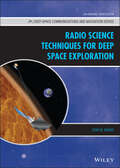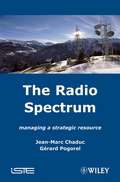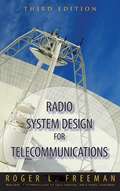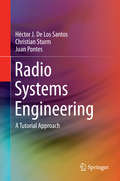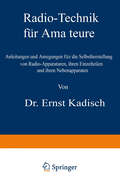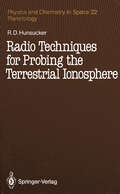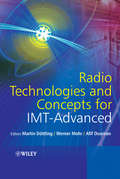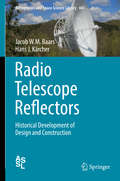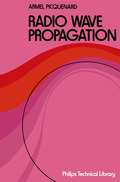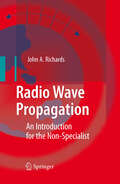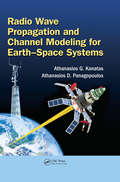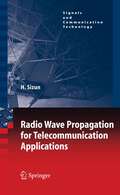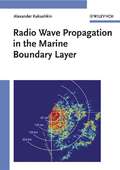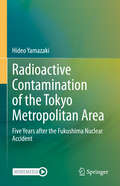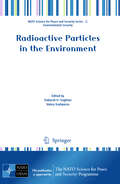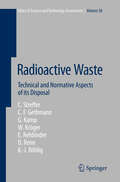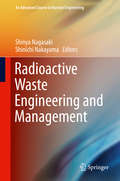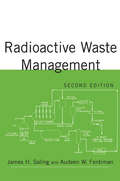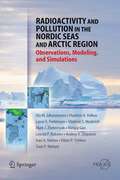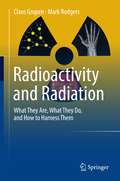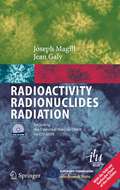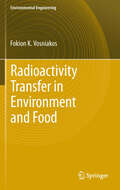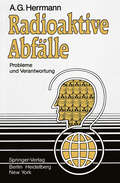- Table View
- List View
Radio Science Techniques for Deep Space Exploration (JPL Deep-Space Communications and Navigation Series)
by Sami W. AsmarExplore the development and state-of-the-art in deep space exploration using radio science techniques In Radio Science Techniques for Deep Space Exploration, accomplished NASA/JPL researcher and manager Sami Asmar delivers a multi-disciplinary exploration of the science, technology, engineering, mission operations, and signal processing relevant to deep space radio science. The book discusses basic principles before moving on to more advanced topics that include a wide variety of graphical illustrations and useful references to publications by experts in their respective fields. Complete explanations of changes in the characteristics of electromagnetic waves and the instrumentation and technology used in scientific experiments are examined. Radio Science Techniques for Deep Space Exploration offers answers to the question of how to explore the solar system with radio links and better understand the interior structures, atmospheres, rings, and surfaces of other planets. The author also includes: Thorough introductions to radio science techniques and systems needed to investigate planetary atmospheres, rings, and surfaces Comprehensive explorations of planetary gravity and interior structures, as well as relativistic and solar studies Practical discussions of instrumentation, technologies, and future directions in radio science techniques Perfect for students and professors of physics, astronomy, planetary science, aerospace engineering, and communications engineering, Radio Science Techniques for Deep Space Exploration will also earn a place in the libraries of engineers and scientists in the aerospace industry.
The Radio Spectrum: Managing a Strategic Resource
by Jean-Marc Chaduc G¿rard PogorelRadio frequencies have become a basic resource for the development of the information society. In fact, radio waves are a mandatory vehicle in order to carry the message to customers and a truly worldwide communication needs their properties. Given the market demands for more and more frequencies, means have to be found to share this limited resource most effectively and to continuously improve its efficiency. Radio spectrum management is thus a major objective for our modern world. This book describes the current tools for spectrum management with their fundamental technical and legal basis. It outlines the global evolution of radio services in their different application domains and introduces the actors who contribute to the collective management of the spectrum. It also discusses the main questions these actors have to deal with and answer in order to design for the future.
Radio System Design for Telecommunications (Wiley Series in Telecommunications and Signal Processing #98)
by Roger L. FreemanStep-by-step tutorial to master current design techniques for wireless communication systems The Third Edition of Radio System Design for Telecommunications brings this highly acclaimed book fully up to date with the latest technological advances and new applications. At the same time, the hallmarks of the previous editions, including the text's popular tutorial presentation, have been retained. Readers therefore get all the tools and guidance they need to master an essential set of current design techniques for radio systems that operate at frequencies of 3 MHz to 100 GHz. Using simple mathematics, the author illustrates design concepts and applications. The book's logical organization, beginning with a discussion of radio propagation problems, enables readers to progressively develop the skills and knowledge needed to advance in the text. Topics that are new to the Third Edition include: Chapter devoted to wireless LANs (WLANs) as detailed in IEEE 802.11 Subsections covering IEEE 802.15, 802.16, 802.20, and the wireless metropolitan area network (WMAN) WiFi, WiMax, and UWB applications that have recently experienced explosive growth Broadband radio in telecommunications, as well as offset frequency division multiplex (OFDM), a new technique for transmitting information in an interference environment The use of very small aperture satellite terminal (VSAT) systems as an economical alternative to public switched telecommunication networks (PSTN) Review questions and problems at the end of each chapter engage readers' newfound skills and knowledge and help them assess whether they are ready to progress to the next chapter. References are provided for readers who want to investigate particular topics in greater depth. Students in wireless telecommunications will find the book's tutorial style ideal for learning all the ins and outs of radio system design, whereas professionals in the industry will want to refer to the Third Edition for its clear explanations of the latest technology and applications.
Radio Systems Engineering: A Tutorial Approach
by Héctor J. De Los Santos Christian Sturm Juan PontesThis book is intended for readers who already have knowledge of devices and circuits for radio-frequency (RF) and microwave communication and are ready to study the systems engineering-level aspects of modern radio communications systems. The authors provide a general overview of radio systems with their components, focusing on the analog parts of the system and their non-idealities. Based on the physical functionality of the various building blocks of a modern radio system, block parameters are derived, which allows the examination of their influence on the overall system performance. The discussion is complemented by tutorial exercises based on the Agilent SystemVue electronic system-level (ESL) design software. With these tutorials, readers gain practical experience with realistic design examples of radio transmission systems for communications and radar sensing. The tutorials cover state-of-the-art system standards and applications and consider the characteristics of typical radio-frequency hardware components. For all tutorials, a comprehensive description of the tasks, including some hints to the solutions, is provided. The readers are then able to perform these tasks independently. A complete set of simulation models and solutions to the tutorial exercises is given.
Radio-Technik für Amateure: Anleitungen und Anregungen für die Selbstherstellung von Radio-Apparaturen, ihren Einzelteilen und ihren Nebenapparaten
by Ernst KadischDieser Buchtitel ist Teil des Digitalisierungsprojekts Springer Book Archives mit Publikationen, die seit den Anfängen des Verlags von 1842 erschienen sind. Der Verlag stellt mit diesem Archiv Quellen für die historische wie auch die disziplingeschichtliche Forschung zur Verfügung, die jeweils im historischen Kontext betrachtet werden müssen. Dieser Titel erschien in der Zeit vor 1945 und wird daher in seiner zeittypischen politisch-ideologischen Ausrichtung vom Verlag nicht beworben.
Radio Techniques for Probing the Terrestrial Ionosphere (Physics and Chemistry in Space #22)
by Robert D. HunsuckerIn the years since the pioneering efforts of Sir Edward Appleton, M. A. F. Barnett, G. Breit, and M. A. Thve, many radio techniques have been employed to investigate the terrestrial ionosphere. The purposes of this book are to exam ine the basic physical interaction process of radio waves with the ionosphere, scrutinize each of the radio techniques currently in use, and describe the elements of each technique, as well as assess their capabilities and limitations. I have included some of the history of each technique, since we often tend to forget the efforts of the "pioneers". The interaction of radio waves with the terrestrial ionosphere has been described in considerable detail in several "classic" treatments, e.g., Ratcliffe (1959), Al'pert (1963), Budden (1961) and Davies (1965), Rishbeth and e.g., Flock (1979), Davies Garriott (1969), and in other more recent books, (1990), Hargreaves (1979), and Budden (1985). A few of the radio techniques have been described by Hargreaves (1979) and a book by Giraud and Petit (1978) has also included discussion of several of the techniques. The "WITS" handbook No. 2 (1989) also contains description of several radio techniques.
Radio Technologies and Concepts for IMT-Advanced
by Martin Döttling Werner Mohr Afif OsseiranRadio Technologies and Concepts for IMT-Advanced presents the findings of the Wireless World Initiative New Radio (WINNER) project in Framework Program 6 of the European Commission. It provides an insight into the key concepts and technologies for the IMT-Advanced radio interface, based on the collaborative research of manufacturers, network operators, research centres and universities within WINNER. The book covers the fundamental radio characteristics of a typical 4G wireless communication system, focusing on the transceiver’s chain from the physical layer to layers 2 and 3. Starting by defining realistic and futuristic usage scenarios, the authors provide in-depth discussion of key technologies including modulation and coding, link level procedures, spatial-temporal processing, multiple access schemes and inter-cell interference mitigation, channel estimation and newly developed channel models. Finally, a cost assessment and optimisation methodology is developed for different deployment concepts in order to assess a wireless system in a condition close to reality. The book provides an important system-level approach to the latest radio technologies in the field, and evaluates IMT-Advanced research in relation to international standardisation. Presents the research findings of IMT-Advanced radio interface from the WINNER project Covers the latest concepts for relaying, multiple access, radio resource control, flexible spectrum use, and ITU-R spectrum demand calculation Examines the most recent Multiple-Input, Multiple-Output (MIMO) techniques, and Distributed Antenna Systems (Coordinated Multipoint Transmissions) Describes a 4G system concept and all major building blocks Provides 4G propagation models and system-level evaluation methodologies
Radio Telescope Reflectors: Historical Development of Design and Construction (Astrophysics and Space Science Library #447)
by Jacob W.M. Baars Hans J KärcherThis book demonstrates how progress in radio astronomy is intimately linked to the development of reflector antennas of increasing size and precision. The authors describe the design and construction of major radio telescopes as those in Dwingeloo, Jodrell Bank, Parkes, Effelsberg and Green Bank since 1950 up to the present as well as millimeter wavelength telescopes as the 30m MRT of IRAM in Spain, the 50m LMT in Mexico and the ALMA submillimeter instrument. The advances in methods of structural design and coping with environmental influences (wind, temperature, gravity) as well as application of new materials are explained in a non-mathematical, descriptive and graphical way along with the story of the telescopes. Emphasis is placed on the interplay between astronomical and electromagnetic requirements and structural, mechanical and control solutions. A chapter on management aspects of large telescope projects closes the book. The authors address a readership with interest in the progress of engineering solutions applied to the development of radio telescope reflectors and ground station antennas for satellite communication and space research. The book will also be of interest to historians of science and engineering with an inclination to astronomy.
Radio Wave Propagation: An Introduction for the Non-Specialist
by John A. RichardsThis work treats the essential elements of radio wave propagation without requiring recourse to advanced electromagnetic concepts and equations. However, it provides sufficient detail to allow those concerned with wireless systems to acquire quickly a practical working knowledge of the important concepts. Radio wave propagation is placed in a practical context by considering the design aspects of communications systems at microwave frequencies. A fuller consideration of the electromagnetic properties of materials is given late in the book rather than as an introductory chapter.
Radio Wave Propagation and Channel Modeling for Earth-Space Systems
by Athanasios G. Kanatas Athanasios D. PanagopoulosThe accurate design of earth–space systems requires a comprehensive understanding of the various propagation media and phenomena that differ depending on frequencies and types of applications. The choice of the relevant channel models is crucial in the design process and constitutes a key step in performance evaluation and testing of earth–space systems. The subject of this book is built around the two characteristic cases of satellite systems: fixed satellites and mobile satellite systems.Radio Wave Propagation and Channel Modeling for Earth–Space Systems discusses the state of the art in channel modeling and characterization of next-generation fixed multiple-antennas and mobile satellite systems, as well as propagation phenomena and fade mitigation techniques. The frequencies of interest range from 100 MHz to 100 GHz (from VHF to W band), whereas the use of optical free-space communications is envisaged.Examining recent research advances in space-time tropospheric propagation fields and optical satellite communication channel models, the book covers land mobile multiple antennas satellite- issues and relative propagation campaigns and stratospheric channel models for various applications and frequencies. It also presents research and well-accepted satellite community results for land mobile satellite and tropospheric attenuation time-series single link and field synthesizers.The book examines aeronautical communications channel characteristics and modeling, relative radio wave propagation campaigns, and stratospheric channel model for various applications and frequencies. Propagation effects on satellite navigation systems and the corresponding models are also covered.
Radio Wave Propagation and Channel Modeling for Earth-Space Systems
by Athanasios G. Kanatas Athanasios D. PanagopoulosThe accurate design of earth–space systems requires a comprehensive understanding of the various propagation media and phenomena that differ depending on frequencies and types of applications. The choice of the relevant channel models is crucial in the design process and constitutes a key step in performance evaluation and testing of earth–space systems. The subject of this book is built around the two characteristic cases of satellite systems: fixed satellites and mobile satellite systems.Radio Wave Propagation and Channel Modeling for Earth–Space Systems discusses the state of the art in channel modeling and characterization of next-generation fixed multiple-antennas and mobile satellite systems, as well as propagation phenomena and fade mitigation techniques. The frequencies of interest range from 100 MHz to 100 GHz (from VHF to W band), whereas the use of optical free-space communications is envisaged.Examining recent research advances in space-time tropospheric propagation fields and optical satellite communication channel models, the book covers land mobile multiple antennas satellite- issues and relative propagation campaigns and stratospheric channel models for various applications and frequencies. It also presents research and well-accepted satellite community results for land mobile satellite and tropospheric attenuation time-series single link and field synthesizers.The book examines aeronautical communications channel characteristics and modeling, relative radio wave propagation campaigns, and stratospheric channel model for various applications and frequencies. Propagation effects on satellite navigation systems and the corresponding models are also covered.
Radio Wave Propagation for Telecommunication Applications (Signals and Communication Technology)
by Hervé SizunRadio Wave Propagation in the Marine Boundary Layer
by Alexander KukushkinBased on his many years of professional experience at leading companies in communications technology, the author describes an analytical solution for wave propagation over the sea surface in an atmospheric boundary layer. His approach allows the detailed analysis of combined effects of diffraction, refraction and scattering in random media. While specific applications covered are targeted at radio wave propagation over the sea surface, a similar approach is applicable to many problems in underwater acoustics, seismology, solid matter physics and astrophysics.
Radioactive Contamination of the Tokyo Metropolitan Area: Five Years after the Fukushima Nuclear Accident
by Hideo YamazakiThis book presents the 5-year monitoring of radioactive contamination in the Tokyo metropolitan area due to the Fukushima accident, covering radiation monitoring of soil, litter, river, water, seawater, aquatic sediments, fish and shellfish, and plants in urban areas. Based on spatial and temporal data, it evaluates the environmental radiation contamination of the Tokyo metropolitan following the first nuclear accident affecting an urban area since Chernobyl. Since little is known about the contamination in Kiev city, this data is particularly valuable, offering insights into the dynamics of radioactive contamination in metropolitan areas, which are of interest in relation to the behavior of radionuclides resulting not only from nuclear accidents but also from nuclear terrorism? As such, this book will be appeal to nuclear and radiation experts, environmental administration professionals and specialists in environmental protection groups, as well as student and academics in the related fields.
Radioactive Particles in the Environment (NATO Science for Peace and Security Series C: Environmental Security)
by Deborah Oughton Valery KashparovRadioactive particles have been released to the environment from a number of sources, including nuclear weapon tests, nuclear accidents and discharges from nuclear installations. Particle characteristics influence the mobility, biological uptake and effects of radionuclides, hence information on these characteristics is essential for assessing environmental impact and risks. This publication presents a series of papers covering sources and source term characterisation, methodologies for characterizing particles, and the impact of particles on the behaviour of radioactive particles in the environment. Sources covered include the Chernobyl accident, nuclear weapons accidents at Thule and Palomares accident, the discharges from Dounreay and Krashnoyarsk, and depleted uranium in Kosovo and Kuwait. The overall aim is that an increased understanding of particle characteristics and behavior will help to reduce some of the uncertainties in environmental impact and risk assessment for particle contaminated areas.
Radioactive Waste: Technical and Normative Aspects of its Disposal (Ethics of Science and Technology Assessment #38)
by Christian Streffer Carl Friedrich Gethmann Georg Kamp Wolfgang Kröger Eckard Rehbinder Ortwin RennRadioactive waste (above all highly radioactive wastes from nuclear installations) caused by research, medicine and technology must be disposed of safely. However both the strategies disputed for the disposal of radioactive waste as well as concrete proposals for choosing a location for final waste disposal are highly debatable. An appropriate disposal must conform to both complex, technical requirements and fulfill the radio-biological conditions to appropriately protect man and nature. Ethical, legal and social conditions must also be considered. An interdisciplinary team from various, relevant fields compiled the current status-quo and developed criteria and strategies, which on the one hand meet the requirements of optimal warning and prevention of risk for present and future generations, and additionally on the other hand meet the needs of what current society agrees what is expected to be allowed. This study can be understood as an advanced and continuing contribution to the corresponding scientific specialized debates, due to its interdisciplinary treatment. At the same time it serves as a fundamentally informing contribution to public and political debates, offering an easily comprehensible executive summary and precise content recommendations.
Radioactive Waste Engineering and Management (An Advanced Course in Nuclear Engineering #6)
by Shinya Nagasaki Shinichi NakayamaThis book describes essential and effective management for reliably ensuring public safety from radioactive wastes in Japan. This is the first book to cover many aspects of wastes from the nuclear fuel cycle to research and medical use, allowing readers to understand the characterization, treatment and final disposal of generated wastes, performance assessment, institutional systems, and social issues such as intergenerational ethics. Exercises at the end of each chapter help to understand radioactive waste management in context.
Radioactive Waste Management
by James SalingThis reviews sources of radioactive waste and introduces radioactive decay and radiation shielding calculations. It covers technical and regulatory aspects of waste management with discussion questions at the end of each chapter to provide an opportunity to explore the many facets of waste management issues. An extensive reference list at the end of each chapter retains the references from the first edition of the book and incorporates references used in preparing this revised text, giving readers an opportunity to look at historical records as well as current information.
Radioactive Waste Management
by James SalingThis reviews sources of radioactive waste and introduces radioactive decay and radiation shielding calculations. It covers technical and regulatory aspects of waste management with discussion questions at the end of each chapter to provide an opportunity to explore the many facets of waste management issues. An extensive reference list at the end of each chapter retains the references from the first edition of the book and incorporates references used in preparing this revised text, giving readers an opportunity to look at historical records as well as current information.
Radioactivity and Pollution in the Nordic Seas and Arctic: Observations, Modeling and Simulations (Springer Praxis Books)
by Olaf M. Johannessen Vladimir A. Volkov Lasse H. Pettersson Helge Drange Yongqi Gao Vladimir S. Maderich Ivan A. Neelov Sven P. Nielsen Leonid P. Bobylev Andrey V. Stepanov Mark J. Zheleznyak Victor TishkovThis book describes a new tool called the Generic Model System for simulations and assessment of potential radioactive spreading in the Arctic regions. It considers the present and future potential for spreading of radionuclear pollution from sources such as from the major Russian processing plants as well as from European sources such as the UK Sellafield plant. The book combines the expertise of professionals from the radionuclear and climate-change sciences.
Radioactivity and Radiation: What They Are, What They Do, and How to Harness Them
by Claus Grupen Mark RodgersThis book lays the foundations for you to understand all that you always wanted to know about radioactivity. It begins by setting out essential information about the structure of matter, how radiation occurs and how it can be measured. It goes on to explore the substantial benefits of radioactivity through its many applications, and also the possible risks associated with its use.The field of radioactivity is explained in layman’s terms, so that everybody who is interested can improve their understanding of issues such as nuclear power, radiation accidents, medical applications of radiation and radioactivity from the environment.Everything is radioactive. There is natural radioactivity in the homes that we live in, the food that we eat and the air that we breath. For over 100 years, people have recognised the potential for radioactivity to help solve problems and improve our standard of living. This has led to the creation of radioactivity levels in some places that are much higher than naturally-occurring background levels. Such high levels of radiation can be harmful to people and the environment, so there is a clear need to manage this potential harm and to make the risk worth the benefits mankind can achieve from radioactive materials.
Radioactivity Radionuclides Radiation
by Joseph Magill Jean GalyOffers basic data on more than 3,600 radionuclides.Emphasizes practical application such as basic research, acheo0logy and dating, medical radiology and industrial.Balanced and informative details on the biological effects of radiation and resultant controversy.Trimmed down student version of a product that costs many times the price.
Radioactivity Transfer in Environment and Food (Environmental Science and Engineering)
by Fokion K VosniakosThe book deals with various consequences of major nuclear accidents, such as in 1986 in Chernobyl and in 2011 in Fukushima. The public is extremely interested in learning more about the movements and risks posed by radiation in the environment related to food supply and food safety. Radionuclides are found in air, water, soil and even in us not only after nuclear accidents because they occur also in nature. Every day, we ingest and inhale radionuclides in our air and food and the water. This book provides a solid underpinning of the basic physical-chemistry and biogeochemistry of naturally occurring and anthrop radioactivity. The mechanisms of radioactive element transfer in the atmosphere, tropospheric and stratospheric diffusion of radioactivity, environmental contamination from accidents and the impact of atmospheric pollution on the food chain, soil and plants, are analyzed and the analytical methods are illustrated. The question of natural radioactivity concentration in building materials is addressed too. While the book contains many case studies and data for Greece, it is of general value. It contributes to the development of international environmentally safe standards and economically reasonable standard regulations based on justified radiological, social and economical legislation concepts.
